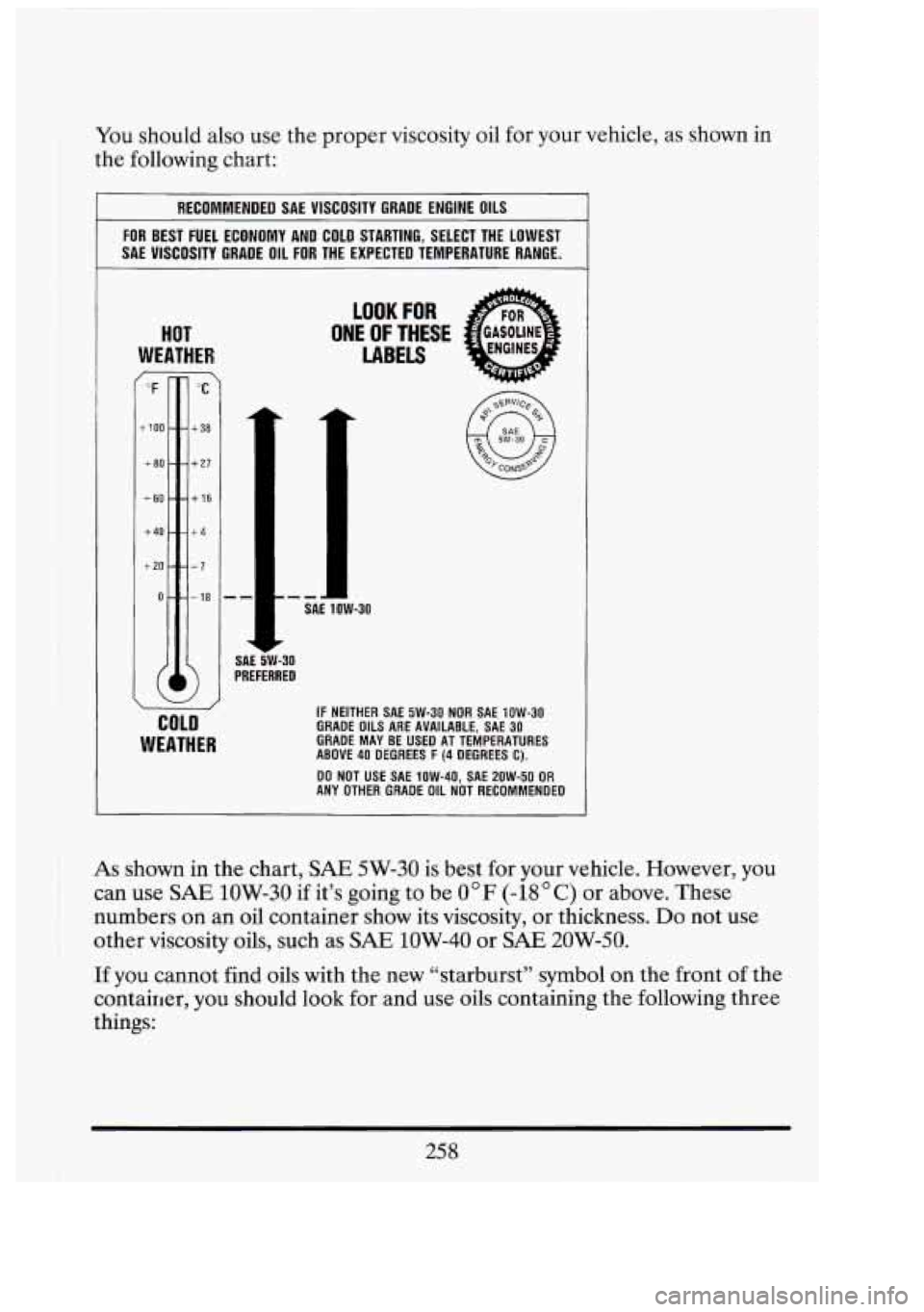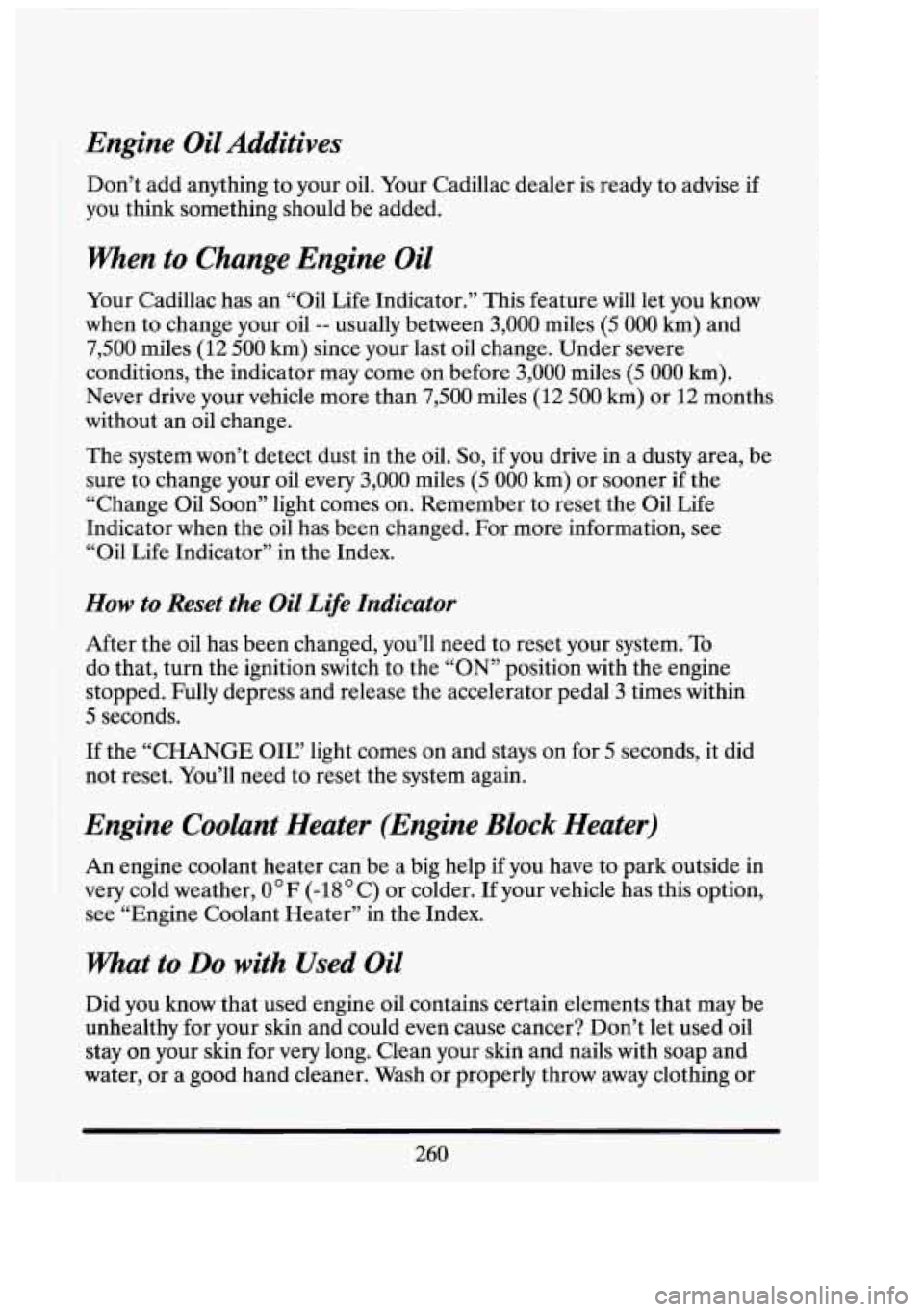Page 261 of 398

I
I
You should ask your service station operators if their gasolines contain
deposit control additives and oxygenates, and if they have been
reformulated to reduce vehicle emissions.
FUELS IN FOREIGN COUNTHES
If you plan on driving in another country outside the U.S. or Canada,
unleaded fuel may be hard to find. Do not use leaded gasoline. If you use
even one tankful, your emission controls won’t work well or at all. With
continuous use, spark plugs can get fouled, the exhaust system can
corrode, and your engine oil can deteriorate quickly. Your vehicle’s
oxygen sensor will be damaged. All
of that means costly repairs that
wouldn’t be covered by your warranty.
To check on fuel availability, ask an auto club, or contact a major oil
company that does business
in the country where you’ll be driving.
You can also write us at the following address for advice. Just tell us
where you’re going and give your Vehicle Identification Number (VIN).
General Motors Overseas Distribution Corporation,
North American Export Sales (NAES)
1908 Colonel Sam Drive
Oshawa, Ontario
LlH 8P7
FUEL ECONOMY
Your fuel economy (miles per gallon or liters per 100 kilometers) can vary
depending on how your Cadillac
is driven. Several vehicles like yours
have been driven through a standard test and their actual fuel economy
was recorded. These readings were adjusted and printed on the fuel
economy window sticker which was attached to your new Cadillac when
it
was delivered and in the Gas Mileage Guide which is available from your
dealership.
The fuel economy estimates are based on results of tests required by the
U. S. Environmental Protection Agency (EPA). These tests are used to
certify that vehicles meet the Federal emissions and fuel economy
standards. Cadillac tests prototypes of new vehicles and submits the
results to the EPA. The EPA then confirms the accuracy of the figures
provided by Cadillac. The vehicles are driven
by a professional driver
under controlled laboratory conditions, on an instrument similar to a
ni
I
I
o(
L
nl
248
Page 267 of 398
Before closing the hood, be sure all the filler caps are on properly. Then
just pull the hood down and close it firmly.
ENGINE OIL
If the LOW OIL LEVEL light on the instrument panel comes on, it
means you need to check your engine oil level right away.
For more.
information, see Low Oil Level light in the Index.
You should check your-
engine oil level regularly; this is .an, added reminder.
It's
a good idea to check your engine oil every time you get fuel. In order
to get an accurate reading, the oil must be warm and the vehicle must be
om level ground.
t
E
-4
254
Page 268 of 398
To Check Engine Oil
Turn off the engine and give the oil a few minutes to drain back into the
oil pan. If you don't, the oil dipstick might not show the actual level.
I Pull out the dipstick
slightly. Pinch the end
of the dipstick tube as
you remove the
dipstick to wipe the oil
from it. Then push it
all the way back in.
Now remove it without
pinching the tube,
keeping the tip lower.
Page 269 of 398
When to Add Oil
If the oil is at or below the ADD line, then you’ll need to add some oil.
But you must use the right kind. This section explains what kind
of oil to
use.
For crankcase capacity, see “Capacities and Specifications” in the
Index.
I
NOTICE:
Don’t add too much oil. If your engine has so much oil that the
oil level gets above the cross-hatched area that shows the proper
operating range, your engine could be damaged.
256
Push the dipstick all
the way back in when
you’re through. :f
Page 270 of 398
r What Kind of Oil to Use
Beginning midyear 1993, oils of the proper quality for your vehicle will be
identified with this new “starburst” symbol. The “starburst” symbol
indicates that the oil has been certified by the American Petroleum
Institute
(MI), and is suitable for use in your gasoline engine.
You should look for this on the front of the oil container, and use only
oils that display this new symbol.
257
Page 271 of 398

You should also use the proper viscosity oil for your vehicle, as shown in
the following chart:
RECOMMENDED SAE VISCOSITY GRADE ENGINE OILS
FOR BEST FUEL ECONOMY AND COLD STARTING, SELECT THE LOWEST
SAE VISCOSITY GRADE OIL
FOR THE EXPECTED TEMPERATURE RANGE.
HOP
WEATHER
7
“F
t 100 .
+80 -
+SO.
+40 -
+20 -
0-
T
”C
t 38
t 27
t 16
t4
-7
- 18
COLD
WEATHER
-- PREFERRED SAE I- 5W-30 --. SAt
. L..
LOOK FOR
ONE OF THESE
LABELS
IF NEITHER SAE 5W-30 NOR SAE 1OW-30
GRADE OILS ARE AVAILABLE, SAE 30 GRADE MAY BE USED AT TEMPERATURES
ABOVE 40 DEGREES F (4 DEGREES C).
ANY OTHER GRADE OIL NOT RECOMMENDED DO NOT USE SAE 1OW-40, SAE 20W-50 OR
As shown in the chart, SAE 5W-30 is best for your vehicle. However, you
can use
SAE 1OW-30 if it’s going to be 0°F (-18OC) or above. These
numbers on an oil container show its viscosity, or thickness.
Do not use
other viscosity oils, such as
SAE 1OW-40 or SAE 20W-50.
If you cannot find oils with the new “starburst” symbol on the front of the
container, you should look for and use oils containing the following three
things:
258
ci I
I nI
UI
tl
I
i
Page 272 of 398
0 0
0 SH or SG
“SH”or “SG” must be on the oil container, either by itself or
combined with other quality designations, such as “SWCD,”
“SH,SG,CD,” etc. These letters show American Petroleum Institute
(MI) levels of quality.
SAE 5W-30
Energy Conserving I1
Oils with these words on the container will help you save fuel.
These three things are usually included in a doughnut shaped logo
(symbol) on most containers. If you cannot find oils with the “starburst”
symbol, you should look for oils with the doughnut shaped symbol,
containing the three things noted above.
I NOTICE:
If you use oils that do not have either the “starburst” symbol or
an
API SH designation, you can cause engine damage not
covered by your warranty.
GM Goodwrench@ oil (in Canada, GM Engine Oil) meets all the
requirements for your vehicle.
259
Page 273 of 398

Engine Oil Additives
Don’t add anything to your oil. Your Cadillac dealer is ready to advise if
you think something should be added.
When to Change Engine Oil
Your Cadillac has an “Oil Life Indicator.” This feature will let you know
when to change your oil
-- usually between 3,000 miles (5 000 km) and
7,500 miles (12 500 km) since your last oil change. Under severe
conditions, the indicator may come on before
3,000 miles (5 000 km).
Never drive your vehicle more than 7,500 miles (12 500 km) or 12 months
without an oil change.
The system won’t detect dust
in the oil. So, if you drive in a dusty area, be
sure to change your oil every 3,000 miles
(5 000 km) or sooner if the
“Change Oil Soon” light comes on. Remember to reset the Oil Life
Indicator when the oil has been changed. For more information, see
“Oil Life Indicator” in the Index.
How to Reset the Oil Life Indicator
After the oil has been changed, you’ll need to reset your system. To
do that, turn the ignition switch to the “ON” position with the engine
stopped. Fully depress and release the accelerator pedal
3 times within
5 seconds.
If the “CHANGE OIC’ light comes on and stays on for 5 seconds, it did
not reset. You’ll need to reset the system again.
Engine Coolant Heater (Engine Block Heater)
An engine coolant heater can’be a big help if you have to park outside in
very cold weather,
0 F (-18 C) or colder. If your vehicle has this option,
see “Engine Coolant Heater” in the Index.
What to Do with Used Oil
Did you know that used engine oil contains certain elements that may be
unhealthy for your skin and could even cause cancer? Don’t let used oil
stay
on your skin for very long. Clean your skin and nails with soap and
water, or a good hand cleaner. Wash or properly throw away clothing or
-1
c:
I 3‘
260